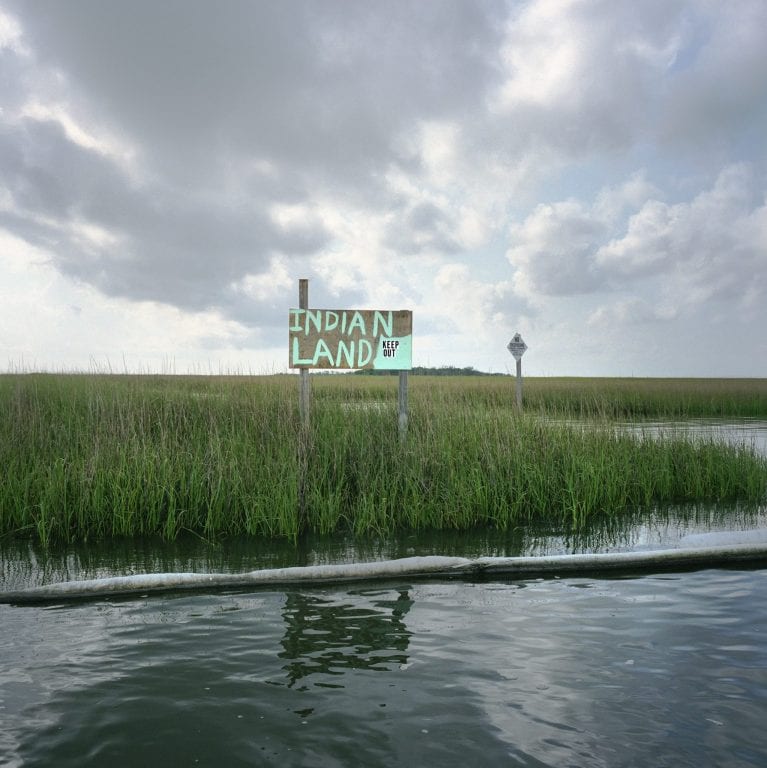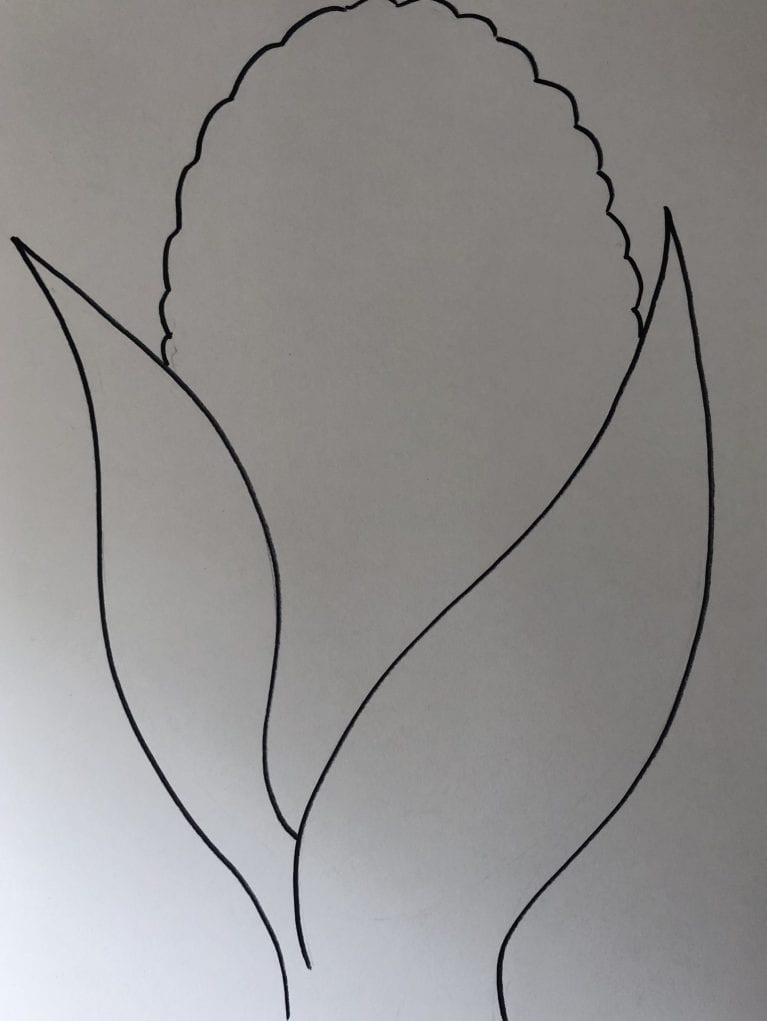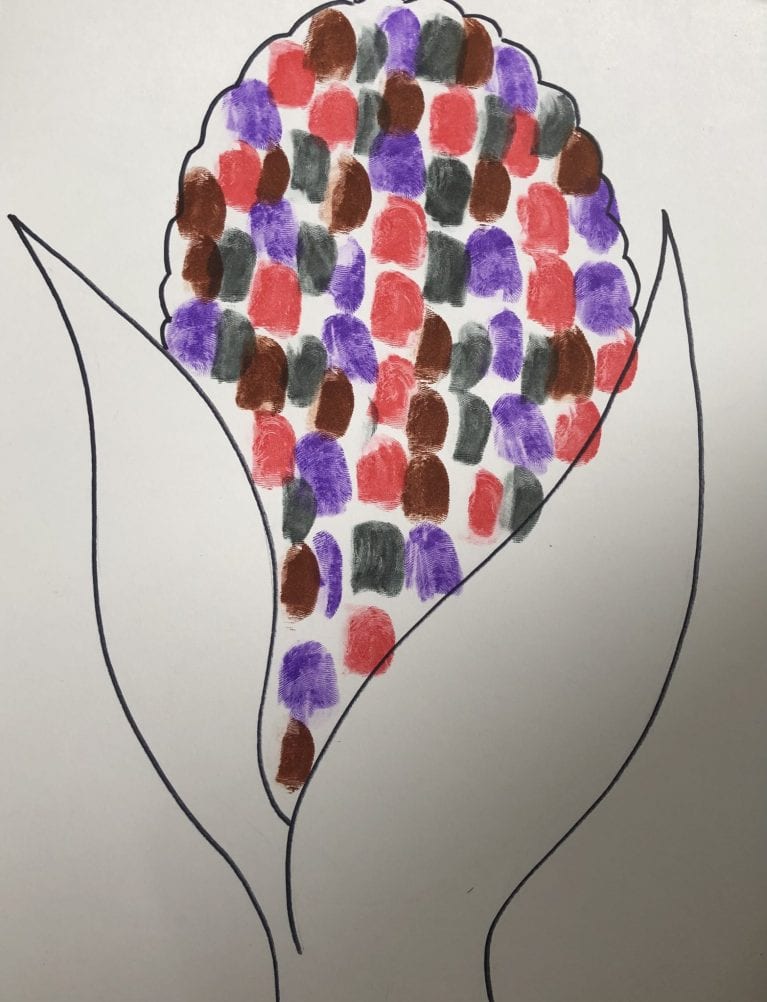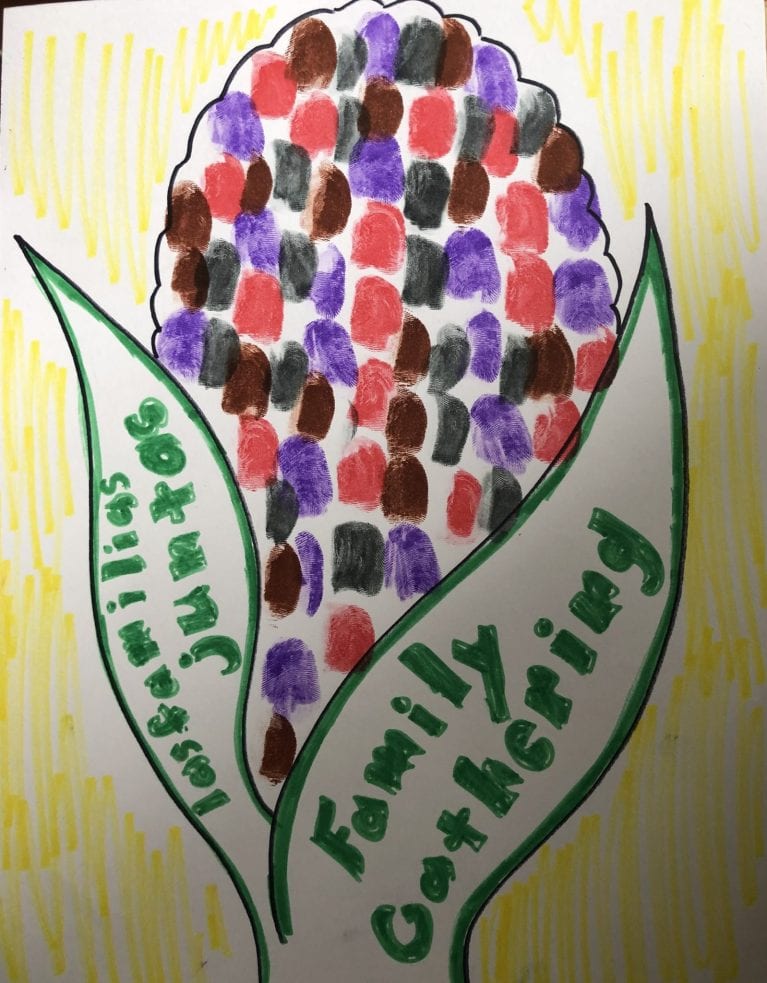Español abajo
Learn about the first people that lived in the Americas and create artwork inspired by this history.

Kael Alford, Indian Land with Oil Boom After BP Oil Spill, South of Pointe-aux-Chene, Louisiana, 2010, Archival pigment print, 20 x 20 inches, Gift of Edwin Robinson, 2018.11.5
New Orleans is referred to as Bulbancha by the Choctaw meaning “the place of many languages” or “the place of many tongues”. The city occupies the territory and traditional homelands of the Chahta Yakni (Choctaw) and Chitimacha.*
Supplies
Template, Washable Markers
Instructions
Step 1: What is your favorite food to eat for Thanksgiving? Food is often an important part of culture. Many Indigenous Peoples have a cultural connection to corn. Corn originated in what is now known as southern Mexico. Before European colonists came to the Americas there were so many different types of corn. Due to the colonization of land and loss of traditional knowledge there are less types existing today.
Step 2: Study the image of the different types of corn. Decide which type of corn you want to create. Pick a color marker to start with.
Step 3: With the permission of a parent or guardian, use the marker to color your thumb. Color it with a few layers. Press your thumb firmly on the corn template to create the “seeds”. Repeat with different colors and fill the area of the corn.
Step 4: The holiday of Thanksgiving is often a sad time for Indigenous Peoples because it represents the colonization of the Americas. Many Indigenous Peoples are working to keep their traditional culture and knowledge alive. What are some important cultural traditions that your family celebrates during this holiday?
Step 5: Use a marker to write these traditions on the husks (leaves) of the corn. Share your artwork with your friends and family.
Step 6 (Optional): Learn more about the Indigenous Peoples living in your area. With the permission of a parent or guardian, go to the website: https://native-land.ca/ Look up your city. On whose traditional land is your city located? Use books or the Internet to find more information about the people whose land is home to your city.
Step 7 (Optional): Learn more about the origins of the food eaten during Thanksgiving. Using books or the Internet, look up the history of each type of food. Where did it originate? Who were the first people to cultivate this food?
Vocabulary
Indigenous – an adjective use to describe a person, plant, or animal that is native to and originate from a specific area
Colonization – occurs when one country or group of people take control of another country or region and establish a settlement or colony. For example, Jamestown was the first settlement in the American colonies.



CHECK OUT OGDEN MUSEUM ONLINE FOR MORE RESOURCES!
QUESTIONS? EMAIL EDUCATION@OGDENMUSEUM.ORG.
*Darensbourg (Atakapa-Ishak), Jeffery. Bulbancha is Still a Place, no. 1 The Tricentennial Issue, POC Zine Project, 2018.
https://www.native-land.ca/ Temprano, Victor. “NativeLand.ca.” Native Land / Our Home on Native Land, Native Land Digital, 2015, native-land.ca/.
___________________________________________________________________
Actividad artística O-riginal: Dar las gracias y recordar la historia de las Américas
Aprende sobre las primeras personas que vivieron en las Américas y crea obras de arte inspiradas en esta historia.

Kael Alford, Indian Land with Oil Boom After BP Oil Spill, South of Pointe-aux-Chene, Louisiana, 2010, Archival pigment print, 20 x 20 inches, Gift of Edwin Robinson, 2018.11.5
Los Choctaw se refieren a Nueva Orleans como “Bulbancha”, que significa “lugar de muchos idiomas” o “lugar de muchas lenguas”. La ciudad ocupa el territorio y las tierras tradicionales de los Chahta Yakni (Choctaw) y los Chitimacha.*
Materiales
Plantilla, marcadores lavables.
Instrucciones
Paso 1: ¿Cuál es tu comida favorita para el Día de Acción de Gracias? A menudo, la comida es una parte importante de la cultura. Muchos pueblos indígenas tienen una conexión cultural con el maíz. El maíz se originó en lo que ahora se conoce como el sur de México. Antes de que los colonos europeos llegaran a América, había muchos tipos diferentes de maíz. Debido a la colonización de tierras y la pérdida de conocimientos tradicionales, existen menos tipos en la actualidad.
Paso 2: Analiza la imagen de los diferentes tipos de maíz. Decide qué tipo de maíz quieres crear. Elige un marcador de color para empezar.
Paso 3: Pide permiso a un padre o tutor y utiliza el marcador para colorear tu pulgar. Coloréalo con algunas capas. Presiona el pulgar firmemente sobre la plantilla de maíz para crear las “semillas”. Repite con diferentes colores y llena el área del maíz.
Paso 4: La festividad de Acción de Gracias es, a menudo, un momento triste para los pueblos indígenas, porque representa la colonización de las Américas. Muchos pueblos indígenas están trabajando para mantener viva su cultura y conocimientos tradicionales. ¿Cuáles son algunas tradiciones culturales importantes que tu familia celebra durante esta festividad?
Paso 5: Utiliza un marcador para escribir estas tradiciones en la cáscara (hojas) del maíz. Comparte tu obra de arte con tus amigos y familiares.
Paso 6 (Opcional): Busca más información sobre los pueblos indígenas que viven en tu área. Pide permiso a un padre o tutor y visita el sitio web: https://native-land.ca/ Busca tu ciudad. ¿En qué tierra tradicional se encuentra tu ciudad? Utiliza libros o Internet para encontrar más información sobre las personas cuyas tierras son el hogar de tu ciudad.
Paso 7 (Opcional): Busca más información sobre los orígenes de la comida que se come durante el Día de Acción de Gracias. En libros o en Internet, busca la historia de cada tipo de comida. ¿Dónde se originó? ¿Quiénes fueron las primeras personas en cultivar este alimento?
Vocabulario
Indígena: un adjetivo que se usa para describir a una persona, planta o animal que es nativo y se origina en un área específica.
Colonización: ocurre cuando un país o grupo de personas toma el control de otro país o región y establece un asentamiento o colonia. Por ejemplo, Jamestown fue el primer asentamiento en las colonias americanas.



¡VISITA OGDEN MUSEUM ONLINE PARA MÁS RECURSOS!
¿PREGUNTAS? ENVÍA UN EMAIL A EDUCATION@OGDENMUSEUM.ORG.
Translation by Agostina Coll
*Darensbourg (Atakapa-Ishak), Jeffery. Bulbancha is Still a Place, no. 1 The Tricentennial Issue, POC Zine Project, 2018.
https://www.native-land.ca/ Temprano, Victor. “NativeLand.ca.” Native Land / Our Home on Native Land, Native Land Digital, 2015, native-land.ca/.
